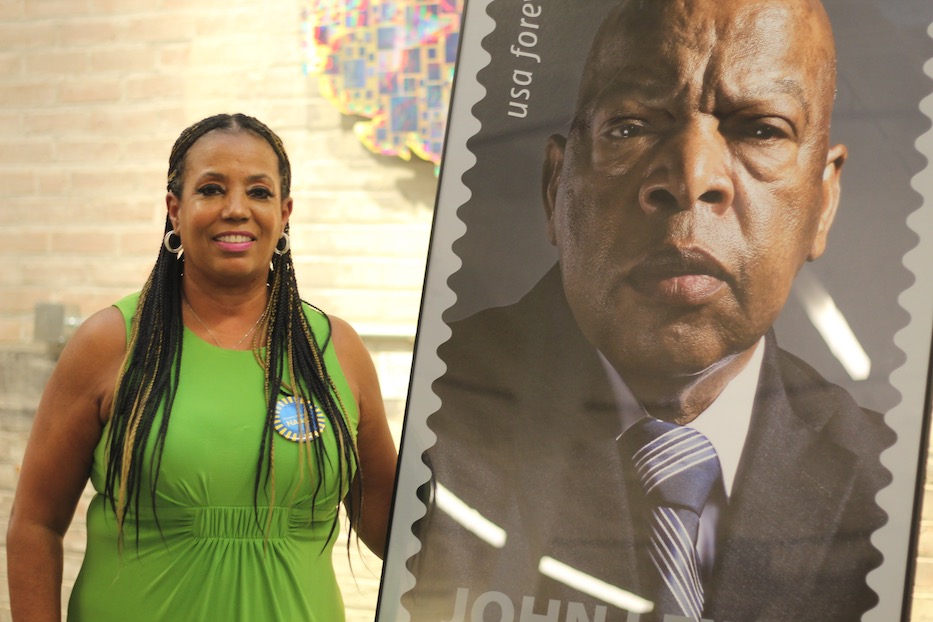
Culture & Community | Dixwell | Music | NXTHVN | Arts & Culture | Greater New Haven NAACP | Arts & Anti-racism | Voting
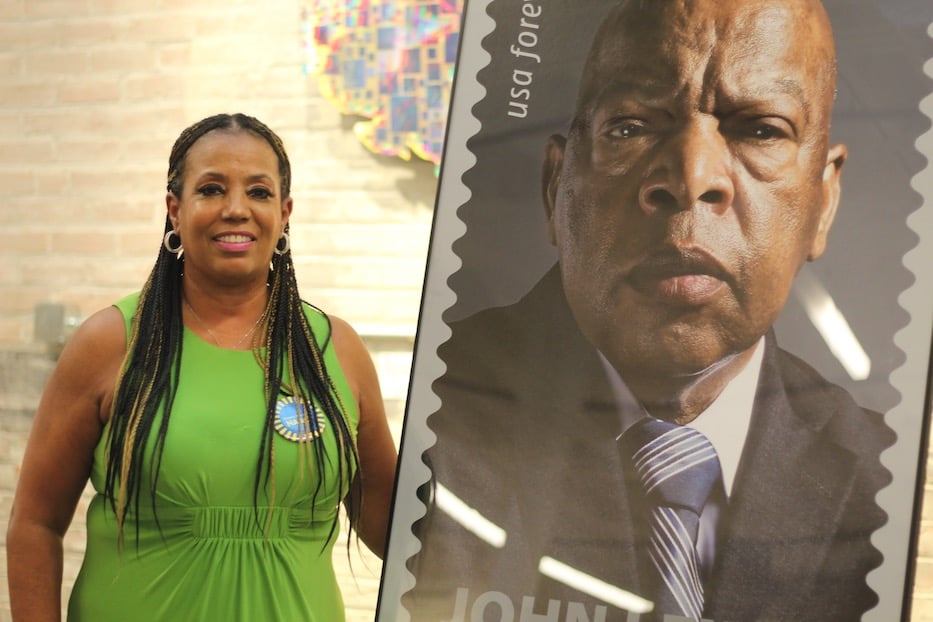
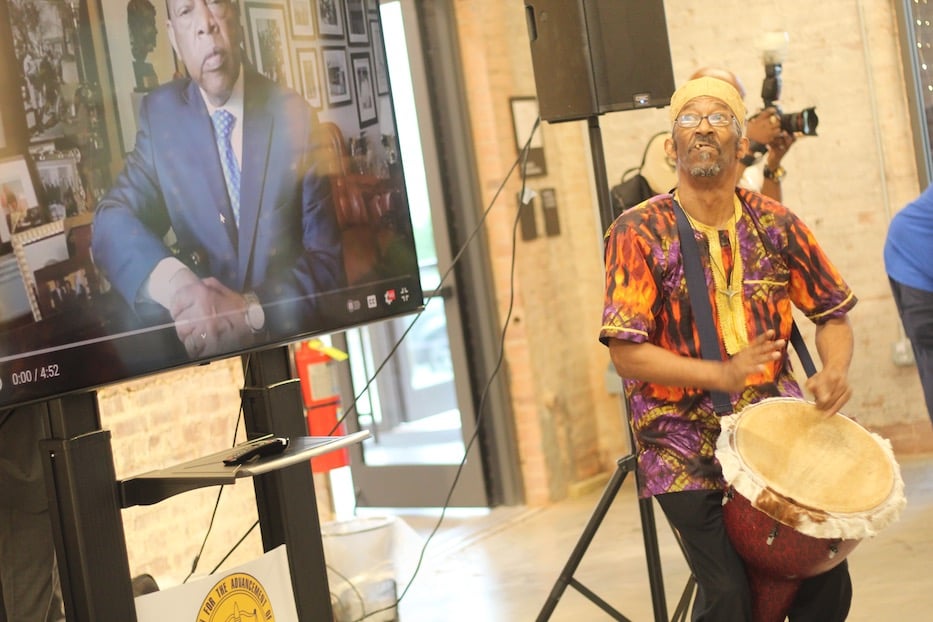
Top: Dori Dumas, president of the Greater New Haven NAACP. Bottom: Drummer Michael Mills, who set the tone for the evening. Lucy Gellman Photos.
The drumbeat rose from the front of NXTHVN, Michael Mills stepping forward as he summoned the sound. He handed a cowbell to Sylvia Haughton, returning with handheld bells for Camille Cooper. Between them, Annie Williams led a clap that caught on. It was a call to do good trouble, delivered in a heartbeat-like rhythm that got the whole room listening.
Somewhere beyond the veil, the late U.S. Rep. John Lewis was dancing along.
Tuesday night, members of the Greater New Haven NAACP, NAACP Legal Defense Fund (LDF), American Civil Liberties Union (ACLU) of Connecticut, Phi Beta Sigma Fraternity, Inc., and the United States Postal Service gathered at NXTHVN to honor and celebrate Lewis’ legacy with the unveiling of the John R. Lewis Heritage Stamp, a national recognition of Lewis’ work and enduring, historic footprint on this country. Close to five dozen attended, including several artists who performed throughout the event.
The unveiling doubled as a celebration of the John R. Lewis Voting Rights Act of Connecticut (originally known as Senate Bill 1226), which passed earlier this year after two legislative sessions of fierce and often partisan debate. When it was signed into law, it made history as “the nation’s most comprehensive state-level voting rights act,” according to the Legal Defense Fund.
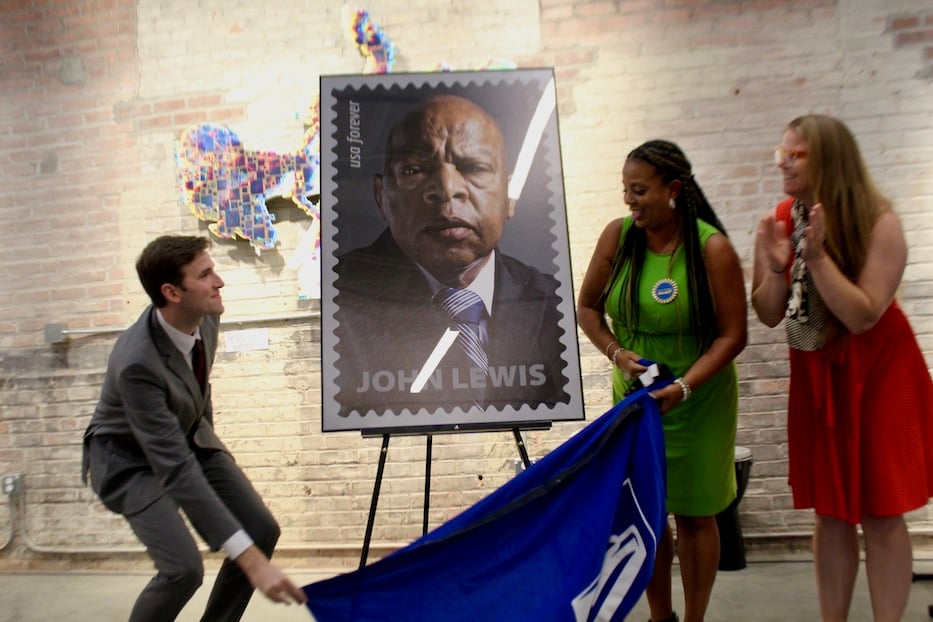
Steven Lance, Dori Dumas, and Amy Gibbs.
“This feels good!” said Dori Dumas, president of the Greater New Haven NAACP, adding that she was ready to hit the ground running at the NAACP’s national convention in Boston on Wednesday. “We have a longstanding relationship with USPS … no matter if it’s an author, if it’s a scientist, if it’s an activist [on the heritage stamp], we’re gonna be there.”
“There are people’s shoulders that we stand on,” she added of Lewis. “So that we could be in this facility. As you know, today people are trying to turn back the clock. We gotta continue with that same spirit.”
Based on a Time Magazine photograph by Marco Grob and first unveiled at Morehouse College on July 21, the stamp depicts in miniature the late U.S. Congressman John R. Lewis, a life force of the Civil Rights Movement who died of pancreatic cancer in July 2020, at the age of 80. Before his death, Lewis made history several times over, as a Freedom Rider, as the youngest person to speak at the 1963 March on Washington, as a leader in the Student Nonviolent Coordinating Committee (SNCC), in the 1965 voting rights campaign and historic Selma to Montgomery March.
On March 7 of that year—a day that became widely known and remembered as “Bloody Sunday”—he was among hundreds on Selma’s Edmund Pettus Bridge who were stopped and brutally assaulted, tear gassed and beaten by police and canines for peacefully refusing to disperse. A leader of the march, Lewis was so severely beaten that the visible and invisible scars of that day, including a slur with which he spoke, remained with him for the rest of his life. 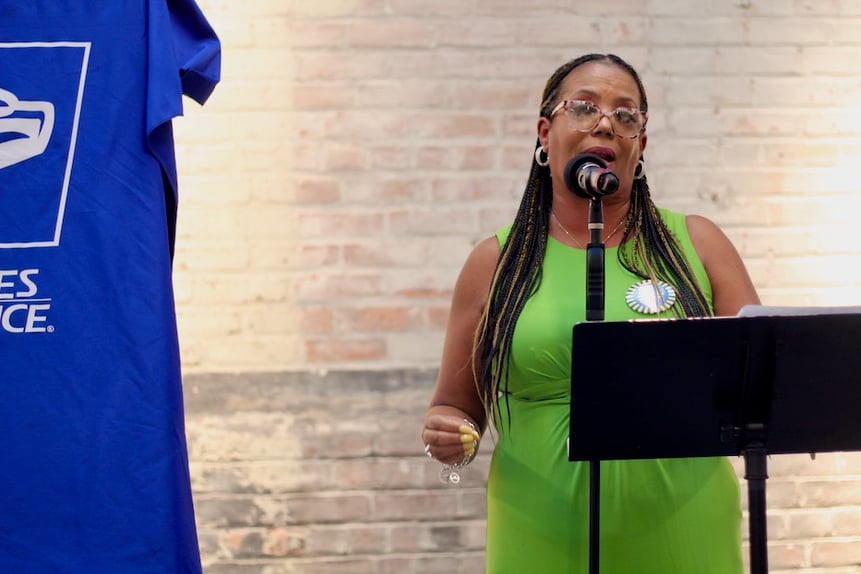
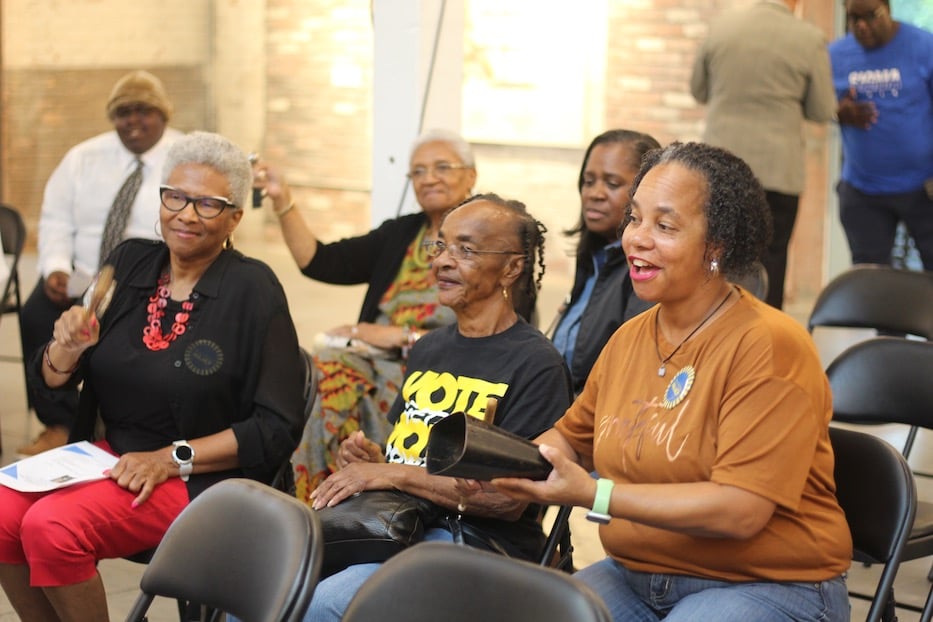
Top: Dumas. Bottom, from left to right: Attendees Camille Cooper, Annie Williams and Sylvia Haughton.
The son of sharecroppers, he never let that threat of race-based violence stop him from making what he called, famously, “good trouble, necessary trouble” for the next five and a half decades. After Selma, Lewis went on to lead the Field Foundation and Voter Education Project, work with and for President Jimmy Carter, and serve 17 terms representing Georgia in the U.S. House of Representatives before his passing.
As he said himself and several speakers echoed throughout the evening: “Our struggle is not the struggle of a day, a week, a month, or a year, it is the struggle of a lifetime.”
On the stamp, designed by USPS Art Director Derry Noyes, Lewis looks straight out at a viewer, his gaze fixed and fiery. Light falls dramatically over half his face, marking his wrinkles, his laugh lines, the fall of his cheeks and furrowed brow. On the left, the words Forever USA scroll by his temples. It marks the third such historic stamp to make an appearance this year, joining depictions of author Ernest Gaines and Supreme Court Justice Ruth Bader Ginsburg.
Tuesday, a lineup of speakers paid homage to that history, which now feels endangered as conservative state legislators introduce measures to disenfranchise Black and Latino voters, ban Black and LGBTQ+ authors and literature, legislate trans people out of existence, and erase curricula that addresses the U.S.’ history of land theft, colonialism, enslavement, redlining and de facto segregation.
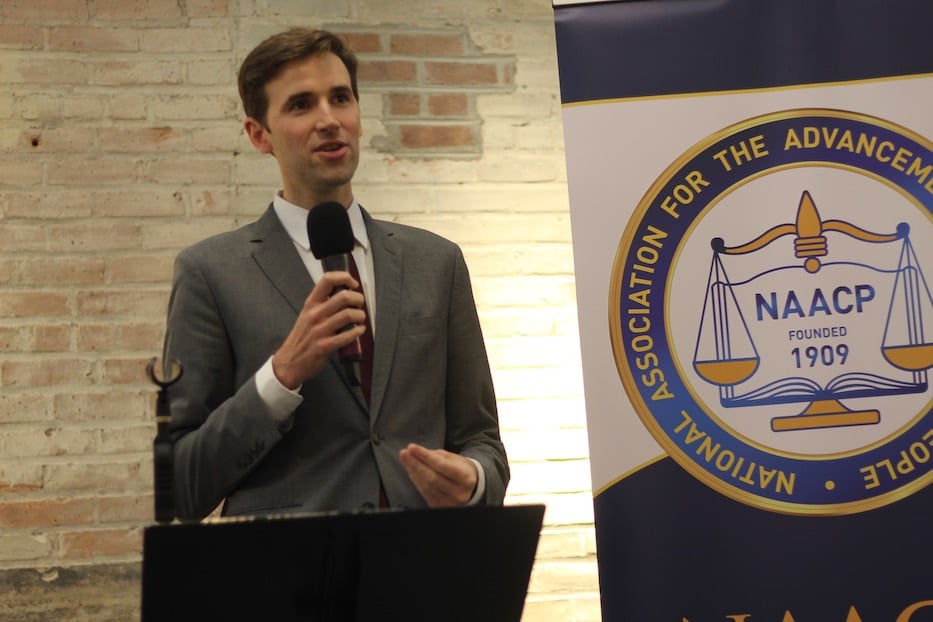 Steven Lance, policy counsel for the Legal Defense Fund.
Steven Lance, policy counsel for the Legal Defense Fund.
Speaking early in the evening, LDF Policy Counsel Steven Lance said he’d been thinking about how fitting a stamp seems for the late congressman, particularly because Lewis himself was an avid stamp collector. When Lance started thinking about Lewis’ legacy, he said, he wondered where to place a monument that could adequately honor Lewis' decades of bravery and public service.
Perhaps, he thought, somewhere along the interstate bus system, where in 1961 Lewis and 12 other Freedom Riders showed that states weren’t following the Supreme Court’s 1960 ruling in Boynton v. Virginia. Or maybe at the base of the Lincoln Memorial, where a young and passionate Lewis spoke during the March on Washington in 1963. Or on the Edmund Pettus bridge, as a statement against police brutality and segregation in a state where Republicans are now actively fighting a Supreme Court ruling that prohibits racial gerrymandering.
“You could put a monument in any of those places, but what I like about these stamps is that they will go everywhere,” Lance said with a smile. Murmurs of agreement rose across the room. He noted that the stamps might travel across a state carrying absentee ballots, voter registration information or first-time filing paperwork for a candidate’s run in city or state government.
Thanks to the John R. Lewis Voting Rights Act of Connecticut, he added, the timing feels especially fitting.
“Connecticut is now an example for other states and for Congress to do the same,” he said.
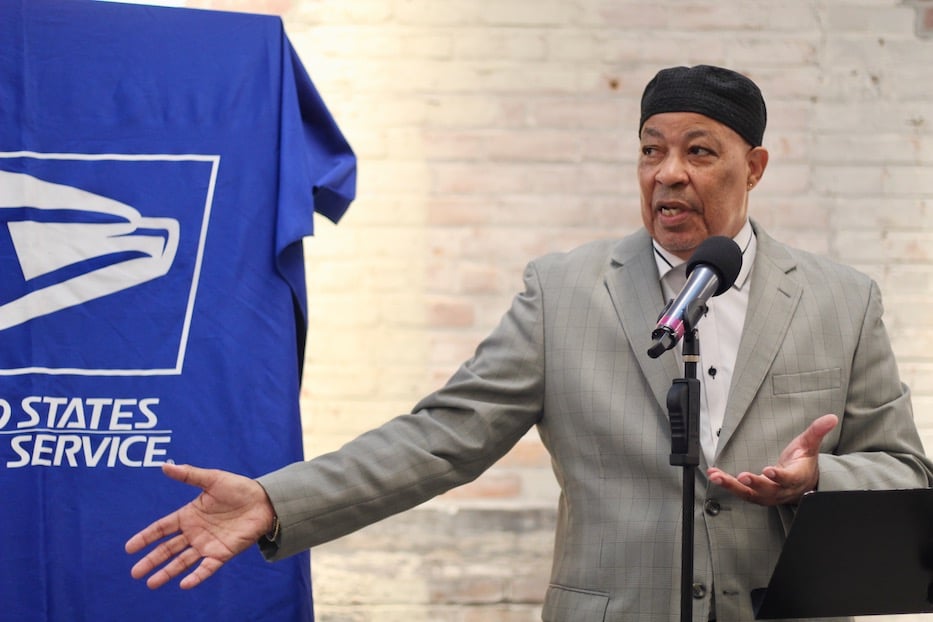
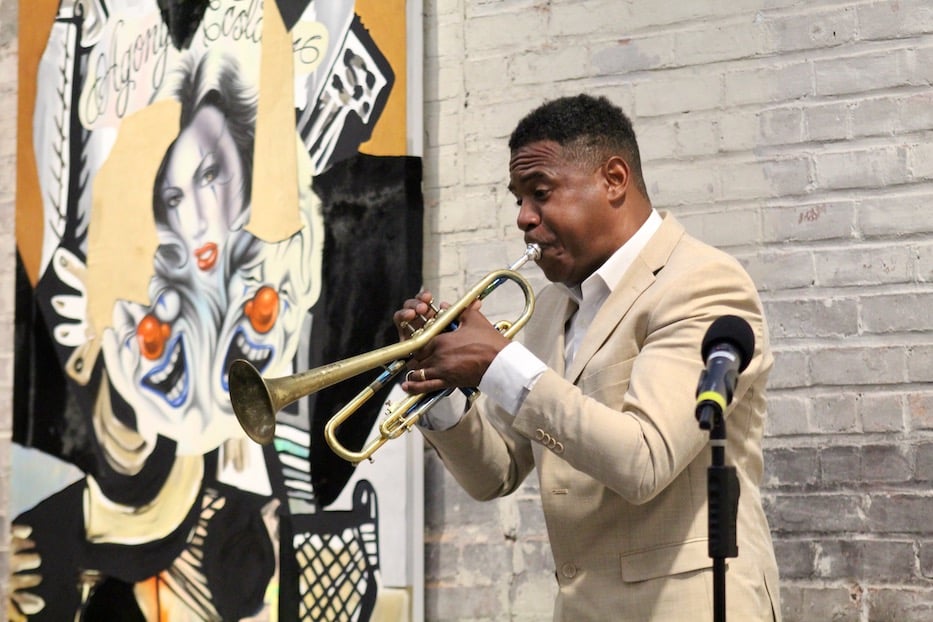
Top: The Honorable Clifton Graves. Bottom: William Fluker, who performed twice during the evening.
Praising Lewis for “getting in some good trouble, some necessary trouble,” Judge Clifton Graves remembered meeting Lewis in 1990, during a 25th anniversary commemoration of Bloody Sunday and the events on the Edmund Pettus Bridge. Part of a delegation from Dixwell Avenue Congregational UCC, “we were honored to see their spirit and their courage,” still very much alive five decades after Lewis nearly lost his life at the hands of white police.
When he gets tired, Graves said, he thinks of that day. He thinks of Lewis, and also the legacy of his colleagues in New Haven, including Dixwell trailblazer Rev. Dr. Edwin R. Edmonds and his daughter, Connecticut State Rep. Toni Edmonds Walker. His words, delivered just blocks from the church’s building, echoed across the room.
“We still have work to do,” he said. “It’s sobering to watch what’s happening in this country.”
He pointed to the Supreme Court of the United States, where a Republican majority has voted to overturn Roe v. Wade, shoot down affirmative action, and strip LGBTQ+ people of their basic equal protections all within the last year.
Those who think of the current court as far-right have not paid sufficient attention to history, he said: the court is doing what it has done for most of its existence. Rulings like Brown v. Board of Education and Loving v. Virginia are still the exception rather than the rule.
“We have to be diligent and we have to persevere,” Graves said. “Our history is one of resistance and resilience.”
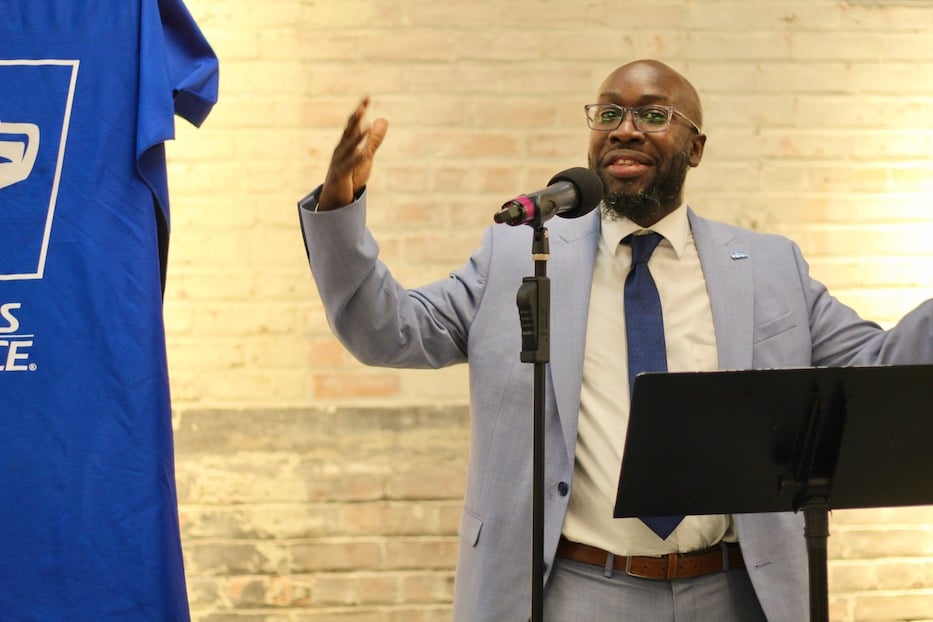
Tai Richardson, president of the Delta Iota Sigma Chapter of the Phi Beta Sigma Fraternity, Inc.
Jess Zaccagnino, policy counsel for the ACLU of Connecticut, added that that means continued diligence and advocacy in the midst of hard-fought celebration. She pointed to the importance of no-excuse absentee voting, early voting, and voting rights for those who are incarcerated or have a prior history of incarceration.
While the John R. Lewis Voting Rights Act of Connecticut is technically the most progressive piece of legislation of its kind in the country, she added, it won’t mean anything if it’s not enforced.
“We need to support the people doing the good work,” echoed Tai Richardson, president of the Delta Iota Sigma Chapter of the Phi Beta Sigma Fraternity, Inc. “Every single morning, he [Lewis] woke up not knowing if he was going to return home. He blindly followed his principles. He blindly followed his values. He blindly followed his morals. He blindly followed his faith.”
“I need you to understand that every single thing he fought for is under attack,” he added, heeding Lewis’ reminder that the struggle for voting rights, social justice and desegregation is long and ongoing.
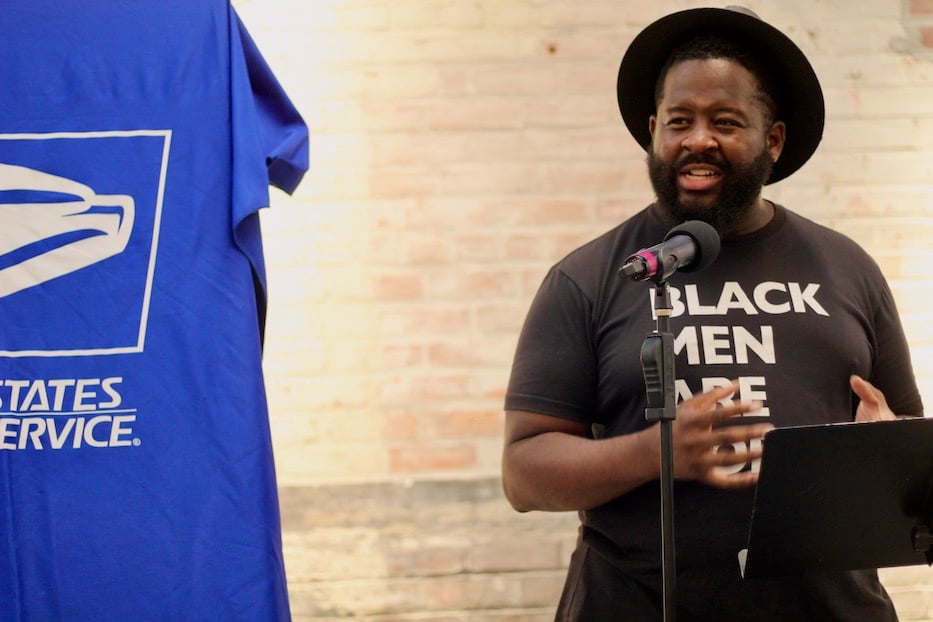
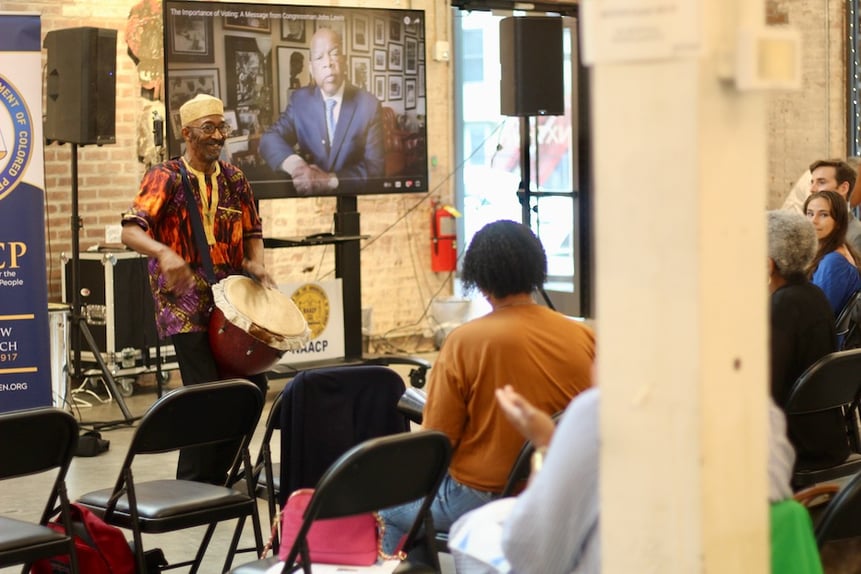
Top: Poet Frank Brady. Bottom: Michael Mills.
Throughout the evening, artists also got onboard, joining the celebration in song, music and spoken word. Taking the occasion as a chance to lift the audience up, veteran educator and master trumpeter William Fluker invited the audience to join in on the downbeats, and later returned with a flugelhorn cover of Master KG’s “Jerusalema.” In between speakers, he looked excitedly to the covered portrait, waiting for the big reveal with a sweet, child-like wonder and reverence.
Taking the stage shortly before the unveiling, poet and spoken word artist Frank Brady shouted out those in the audience “whose shoulders I stand on,” including Graves, playwright Steve Driffin, Higher Heights Youth Empowerment Programs, Inc. Founder Dr. Chaka Felder-McEntire, and Richardson. Beaming, he remembered meeting Lewis in Florida in 2017, at Black Enterprise’s inaugural Black Men XCEL Summit.
“When he walked and when he spoke, there was a certain power to his words,” he said. “There was a certain weight and a heaviness. And that heaviness is built, not bought. You can’t buy that type of power.”
“I believe that you are the sum total of those that you look up to, and those that have invested in you, right?” he said. “You have to acknowledge those that are important to you, cause that sets a precedent for the next generation.”
As his poetry wove through the space—I know a man/That flowed in and out of good trouble/Like a river/Swimmin' through his resolve for miles—Lewis’ portrait waited patiently behind a blue cloth emblazoned with the postal service’s thick logo in white.
Brady tied Lewis’ life and fight for voting rights to a struggle that is ongoing, particularly in states in the South, where so much as giving food and water to voters is now legislated as criminal behavior. Do you know what courage looks like? he asked, and a listener could have heard a pin drop. Do you know what courage looks like, because I do.
In a back row, USPS Strategic Communications Specialist Amy Gibbs held on to each word. She later came to the front to help Dumas and Lance unveil the stamp. As she did, she reminded attendees that letter writing isn’t a lost art at all—and it still very much has a political purpose. Just moments later, with a flourish of her hand, she was helping bring the image to life.
“Formal letter writing remains an effective tool for advocacy,” she said. “And right now, we need his voice more than ever.”
Watch more from the unveiling in the video above.

